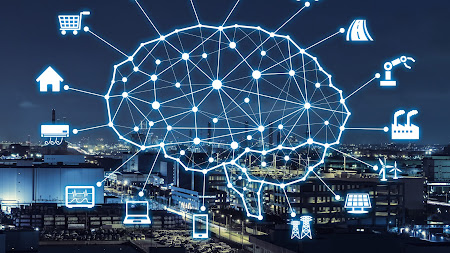What is Artificial Intelligence
The replication of human intelligence functions by machines, particularly computer systems, is known as artificial intelligence. Expert systems, natural language processing, speech recognition, and machine vision are some examples of specific AI applications. To put it another way, artificial intelligence (AI) is a broad field of computer science that focuses on developing intelligent machines that can carry out tasks that traditionally need human intelligence.
Despite the fact that there have been several definitions of artificial intelligence (AI) throughout the past few decades, John McCarthy provides the following definition in this 2004 publication. "Making clever devices, especially intelligent computer programs, is a combination of science and engineering. The job of utilizing computers to understand human intelligence is related, but AI should not be limited to physiologically observable processes."
But years before this definition came into being, in 1950, Alan Turing's landmark paper "Computing Machinery and Intelligence" marked the beginning of the artificial intelligence debate. Can machines think? is the question Turing, who is frequently referred to as the "father of computer science," poses in this essay. Then he proposes a test that has become commonly known as the "Turing Test," in which a human interrogator would attempt to differentiate between a computer-generated and a human-written text response. Although this test has been under intense criticism since it was published, it nonetheless contributes significantly to the history of AI and continues to be a topic of discussion in philosophy because it makes use of linguistic concepts.
Evolution of Artificial Intelligence
AI in the 1800s was largely the subject of myths, fiction, and conjecture. The thinkers of antiquity envisioned machines incorporated into people. But back then, they were only fictionalized in works like Mary Shelley's "Frankenstein." In 1956, the actual initiation of AI took place. During a course held at Darthmod College, participants were touted as potential leaders in artificial intelligence (AI).
The AI boom started with the following six main design aims:
- Train computers to think so they can carry out significant cognitive tasks like playing chess, proving mathematical theorems, and other things.
- Machines needed to be able to recognize objects, people, and languages in order to interact with the actual world like humans do. This required knowledge representation. This is why the programming language Lisp was created.
- Train computers how to explore and operate in the environment we live in. With this, machines would be able to navigate themselves and move about independently.
- Provide computers the ability to grasp natural language so they may comprehend speech, understand dialogues, and comprehend language.
- Enable robots to experience touch, sensation, sight, hearing, and taste the same way humans do.
- A general intellect that comprised creativity, intuition, and emotional intelligence.
These objectives lay the groundwork for creating a machine with human capabilities. Bringing their idea to life cost millions of dollars. The US government rapidly discovered that it lacked the robust computer technology necessary to develop AI, though. In the late 1980s, the money was taken out, and the voyage came to its first halt.
The 1980s saw a slowdown in advancement due to the demand for vast amounts of data and enormous processing power. However, the notion was swiftly revived in the twenty-first century, demonstrating Moore's law. The enormous processing power that today's small silicon's possess has made AI practical and enabled the development of better algorithms.
The resuscitation and revolution of AI have been sparked by four distinct triggers:
- The democratization of AI knowledge started when high-caliber research materials were made accessible to the general public, beginning with MOOCs from Stanford University with Andrew NG and Intro to ML by Sebastian Thurn and Katie Malone from Udacity.
- The availability of data and computing power (cloud and GPU) without a large initial outlay of capital or the need for a mega-corporation makes AI available to the general public.
- Users needed to be expert in AI to use it, even if you had access to data and processing capacity. But in 2015, there was a profusion of new frameworks and tools that allowed the general public to explore and use production-level AI. Now, you can develop on the shoulders of industry titans like Google (Tensorflow) and Facebook ( PyTorch). The democratization of AI has led to the creation of several groups like FastAI and OpenAI.
- Over the last two years, AI as a service has advanced this by making it simpler to prototype, explore, and even include complex and knowledgeable use-case-specific AIs into the product. Platforms that offer AI as a Service include Azure AI, AWS AI, Google Cloud AI, IBM Cloud AI, and many others.
Humankind has witnessed AI identifying cat videos to the invention of self-driving cars. In order to address issues and develop an AI strategy within the company, more businesses are attempting to use AI. Achieving the six objectives set forth at the beginning of the AI journey is being done so now. Future cohabitation of humans and robots is conceivable with continued technological improvement. We now have a choice: we may continue to follow the trend, or we can begin formulating our AI strategy to make a difference in a technologically advanced society.

.png)

.jpg)
Comments
Post a Comment